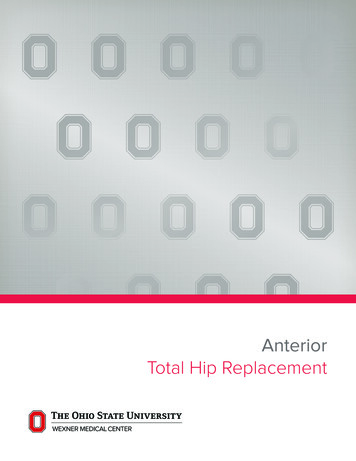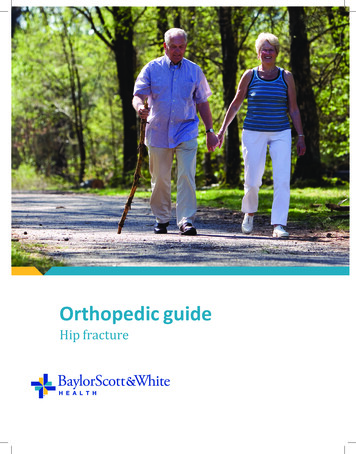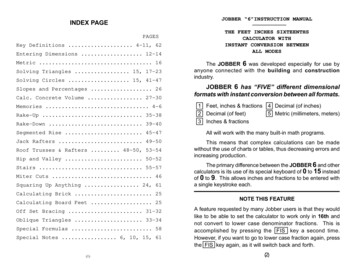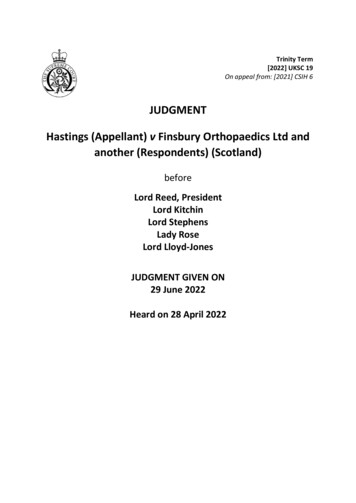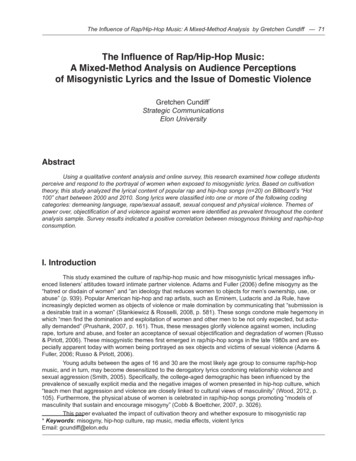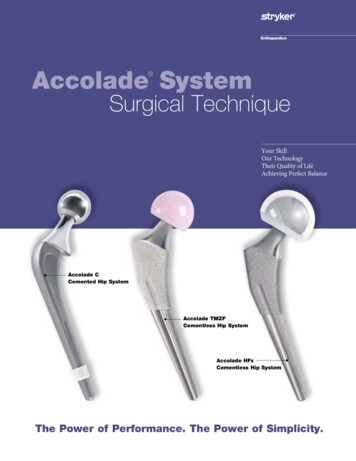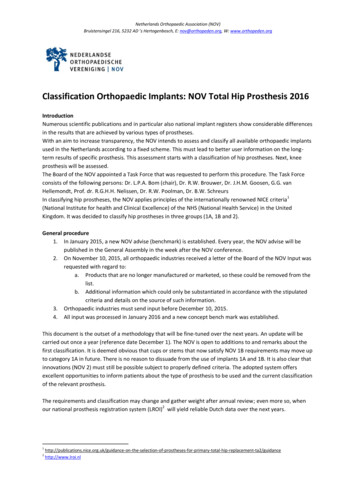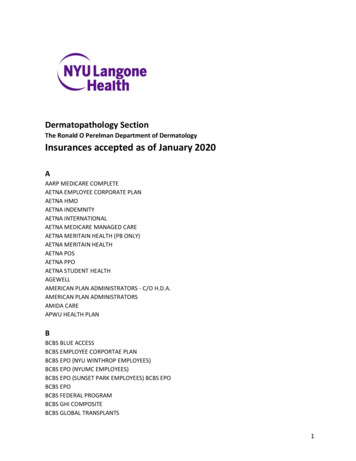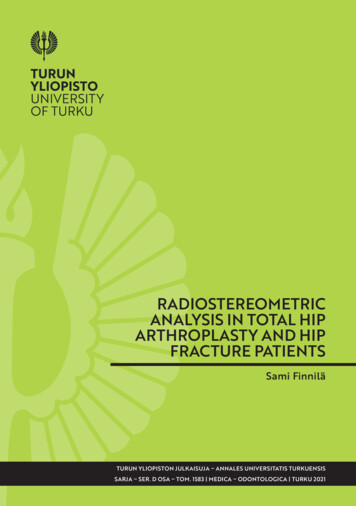
Transcription
RADIOSTEREOMETRICANALYSIS IN TOTAL HIPARTHROPLASTY AND HIPFRACTURE PATIENTSSami FinniläTURUN YLIOPISTON JULKAISUJA – ANNALES UNIVERSITATIS TURKUENSISSARJA – SER. D OSA – TOM. 1583 MEDICA – ODONTOLOGICA TURKU 2021
RADIOSTEREOMETRICANALYSIS IN TOTAL HIPARTHROPLASTY AND HIPFRACTURE PATIENTSSami FinniläTURUN YLIOPISTON JULKAISUJA – ANNALES UNIVERSITATIS TURKUENSISSARJA – SER. D OSA – TOM. 1583 MEDICA – ODONTOLOGICA TURKU 2021
University of TurkuFaculty of MedicineOrthopaedics and TraumatologyDoctoral Programme in Clinical ResearchSupervised byProf. Emeritus Hannu T Aro, MD, PhDDepartment of Orthopaedic Surgery andTraumatology,University of Turku and Turku UniversityHospital, FinlandAdjunct Prof. Niko Moritz, PhDTurku Clinical Biomaterial Centre andInstitute of Dentistry,University of Turku, FinlandReviewed byProf. Miika Nieminen, PhDResearch Unit of Medical Imaging,Physics and Technology,University of Oulu, FinlandAdjunct Prof. Teemu Moilanen, MD, PhDDepartment of Orthopaedic Surgery andTraumatology,University of Tampere, FinlandOpponentProf. Juhana Leppilahti, MD, PhDDepartment of Orthopaedics andTraumatology,Oulu University Hospital, FinlandThe originality of this publication has been checked in accordance with the Universityof Turku quality assurance system using the Turnitin OriginalityCheck service.ISBN 978-951-29-8619-4 (PRINT)ISBN 978-951-29-8620-0 (PDF)ISSN 0355-9483 (Print)ISSN 2343-3213 (Online)Painosalama Oy, Turku, Finland, 2021
To my family: Tiina and Sonja
UNIVERSITY OF TURKUFaculty of MedicineOrthopaedics and TraumatologySAMI FINNILÄ: Radiostereometric Analysis in Total Hip Arthroplasty andHip Fracture PatientsDoctoral thesis, 178 pp.Doctoral Programme in Clinical Research (DPCR)October 2021ABSTRACTComplications related to primary total hip arthroplasty (THA) are relatively rare butstill impose a significant burden on the recovery of individual patients and incursignificant costs to the healthcare system. Research aimed at improving the resultsof THA is challenging as complications can take up to decades to manifest clinically.However, radiostereometric analysis (RSA) can, in some cases, be used to predictthe long-term revision rates of THA with only a two-year follow-up. The purpose ofthis doctoral thesis was to examine the causes of RSA-measured micromotion andto further develop the methodology for the research of THA and hip fracture patients.The first study examined whether preoperative systemic bone mineral density(BMD) had an effect on the early RSA-measured micromotion of a cementlessacetabular cup in female patients with osteoarthritis. The second study consideredthe suitability of model-based RSA (MBRSA) for the analysis of a cementlessfemoral stem using both a phantom model and a clinical cohort. The third studyvalidated differentially-loaded RSA (DLRSA) for the study of internally-fixatedfemoral neck fractures in a clinical cohort of 16 patients. The final study examinedif RSA data analysis would benefit from the use of a multivariate three-dimensionalanalytical method.Low systemic BMD was associated with increased proximal migration of thecementless acetabular cups. The MBRSA proved to have comparable accuracy andprecision compared to conventional RSA thereby validating the method for futureclinical studies using the examined femoral stem. The deployed DLRSAmethodology could be used to detect inducible micromotion of femoral neckfractures. A multivariate linear mixed-effects model could provide a more robust andsensitive method for the analysis of three-dimensional RSA data.KEYWORDS: Radiostereometric analysis, total hip arthroplasty, femoral neckfracture, osteoporosis, three-dimensional micromotion4
TURUN YLIOPISTOLääketieteellinen tiedekuntaOrtopedia ja traumatologiaSAMI FINNILÄ: Radiostereometrinen analyysi lonkan kokotekonivelen jalonkkamurtumien tutkimuksessaVäitöskirja, 178 s.Turun kliininen tohtoriohjelma (TKT)October 2021TIIVISTELMÄLonkan kokotekonivelleikkauksen komplikaatiot ovat harvinaisia mutta aiheuttavatmerkittävää haittaa yksittäisille potilaille sekä merkittäviä taloudellisia kustannuksiaterveydenhuollolle. Tutkimustyö lonkan kokotekonivelleikkauksien tuloksienparantamiseksi on haastavaa, koska komplikaatioiden ilmenemiseen voi kulua jopavuosikymmeniä ja silloinkin harvinaisten komplikaatioiden todentamiseksitarvittaisiin suuria potilasjoukkoja. Radiostereometrisellä analyysillä (RSA) voidaantietyissä tapauksissa kuitenkin ennakoida uusintaleikkauksen riskiä jo kahdenvuoden seuranta-ajalla. Tämän väitöskirjan tavoitteena oli laajentaa nykyistä tietoaRSA:lla mitattavan mikroliikkeen syistä ja merkityksestä sekä kehittää RSAmenetelmää lonkan kokotekonivel- ja lonkkamurtumapotilailla.Ensimmäisessä osatyössä tutkittiin, onko luuntiheydellä merkitystä lonkansementittömän kokotekonivelen kuppiosan RSA:lla mitattuun mikroliikkeeseennivelrikkoa sairastaneilla naispotilailla. Toisessa osatyössä tutkittiin kolmiulotteiseen mallinnukseen perustuvan RSA-menetelmän (MBRSA) soveltuvuutta sementittömän lonkan tekonivelen varren tutkimukseen. MBRSA menetelmää tutkittiinensin fantomia käyttäen ja myöhemmin tulokset varmistettiin lonkan kokotekoniveltutkimukseen osallistuneilla potilailla. Kolmannessa osatyössä selvitettiinkuormituksen aiheuttaman RSA-mikroliikkeen (DLRSA) käyttöä reisiluun kaulanmurtumien tutkimuksessa. Neljännessä osatyössä selvitettiin, hyötyisivätkö RSAtutkimukset moniulotteisesta tilastollisesta menetelmästä.Lonkan sementittömän kokotekonivelen kuppiosan varhainen mikroliike olisuurentunutta potilailla, joiden luuntiheys oli alentunut. MBRSA menetelmäsoveltuu tutkitun tekonivelen varren seurantaan ja käyttöön tulevissa tutkimuksissa.Kehitettyä DLRSA-menetelmää voidaan käyttää reisiluun kaulan murtumientutkimuksessa. Kolmiulotteisella tilastollisella mallintamisella voidaan havaitayksiulotteisia menetelmiä herkemmin ja spesifisemmin eroja RSA-mikroliikkeessä.AVAINSANAT: Radiostereometrinen analyysi, lonkan kokotekonivelleikkaus,lonkkamurtuma, osteoporoosi, kolmiulotteinen mikroliike5
Table of ContentsAbbreviations . 8List of Original Publications . 1012Introduction . 11Review of the Literature . 132.12.22.32.42.5A Brief History of RSA . 13RSA Methodology . 172.2.1 Marker-Based RSA . 172.2.2 Model-Based RSA (MBRSA) . 242.2.3 Inducible Micromotion under Differential Loading . 272.2.4 Accuracy, Precision, and Power Analysis . 282.2.5 Causalities of RSA-Measured Micromotion . 332.2.6 Competitive Methods. 36Clinical Applications of RSA in Cementless THA . 402.3.1 The Coevolution of Cemented and Cementless THA . 402.3.2 The Acetabular Cup . 422.3.3 The Femoral Component – Implant Surface MBRSA . 45Clinical Applications of DLRSA in Fracture Healing Studies . 45Reporting RSA Data and Statistical Analysis. 482.5.1 Reporting RSA-Measured Rigid Body Migration . 482.5.2 Statistical Analysis of RSA Data . 503Aims . 564Hypotheses. 575Materials and Methods . 585.15.25.35.45.566Study I: ABG II Acetabular Cup . 58Study II: MBRSA of the Accolade II Stem . 60Study III: DLRSA of Internally Fixated Femoral NeckFractures . 62Study IV: Multivariate LMM Analysis of Accolade II stem . 65Ethical Considerations . 67Results . 686.16.2Study I: ABG II Acetabular Cup . 68Study II: MBRSA of the Accolade II Stem . 70
6.36.47Study III: DLRSA of Internally Fixated Femoral NeckFractures . 71Study IV: Multivariate LMM Analysis of Accolade II stem. 73Discussion . 767.17.27.37.4Study I: ABG II Acetabular Cup . 76Study II: MBRSA of the Accolade II Stem . 80Study III: DLRSA of Internally Fixated Femoral NeckFractures . 81Study IV: Multivariate LMM Analysis of Accolade II stem. 848Future Prospects . 899Conclusions . 93Acknowledgements . 94References . 96Original Publications . 1117
mic Benoist GirardAnalysis of varianceBone mineral densityBody mass indexComputer-aided designConfidence intervalCondition numberComputed tomographyCT-based implant motion analysisDifferentially-loaded radiostereometric analysisDirect linear transformationDigitally reconstructed radiographDual-energy X-ray absorptiometryEinzel Bild Röntgen AnalyseElementary geometrical shapeFemoral neck shorteningHarris hip scoreIntra-class correlation coefficientImage-based radiostereometric analysisInternational Organization For StandardizationLinear mixed-effects modelLimits of agreementMultivariate analysis of varianceModel-based radiostereometric analysisMean error of rigid-body fittingMaximum total point motionReverse-engineeredRadiostereometric analysisStandard deviation
TTTRTHAWOMACTotal translationTotal rotationTotal hip arthroplastyWestern Ontario and McMaster Universities Osteoarthritis index9
List of Original PublicationsThis dissertation is based on the following original publications, which are referredto in the text by their Roman numerals:IIIIIIIVFinnilä S, Moritz N, Svedström E, Alm JJ, Aro HT. Increased migration ofuncemented acetabular cups in female total hip arthroplasty patients with lowsystemic bone mineral density. A 2-year RSA and 8-year radiographic followup study of 34 patients. Acta Orthopaedica, 2016; 87(1):48–54.Nazari-Farsani S, Finnilä S, Moritz N, Mattila K, Alm JJ, Aro HT. Is modelbased radiostereometric analysis suitable for clinical trials of a cementlesstapered wedge femoral stem? Clinical Orthopaedics and Related Research,2016; 474:2246–2253.Finnilä S, Moritz N, Strandberg N, Alm JJ, Aro HT. Radiostereometricanalysis of the initial stability of internally fixed femoral neck fractures underdifferential loading. Journal of Orthopaedic Research, 2019; 37(1):239–247.Finnilä S, Löyttyniemi E, Aro HT. A randomized denosumab trial of total hiparthroplasty – multivariate reanalysis of cementless femoral component 3Dmigration. Submitted for publication.The original publications have been reproduced with the permission of the copyrightholders.10
1IntroductionTotal hip arthroplasty (THA) is recognized as one of the greatest successes ofmodern orthopaedics (Learmonth et al. 2007). THA is a treatment-of-choice foradvanced hip osteoarthritis – a disease that is one of the most common and, also,most debilitating conditions affecting the elderly worldwide (Murphy et al. 2010,Glyn-Jones et al. 2015). In Finland alone over 10 000 primary THAs are performedeach year – osteoarthritis, femoral neck fracture, and avascular necrosis being thethree most common indications for the procedure (Finnish Arthroplasty Register2021). The worldwide incidence of THA has been estimated to exceed two millionoperations a year by 2030 (Pivec et al. 2012). However, revision surgery as a resultof failing primary joint arthroplasty is associated with significant economic andhumane burden (Weber et al. 2018). Consequently, there is a tremendous incentiveto improve and innovate on the initial success of THA.The research focused on improving the initial success of THA is notstraightforward. The clinical manifestation of complications can take decades(Michelson and Riley 1989). To solve this issue, radiostereometric analysis (RSA)has emerged as a key research method in the clinical introduction of THAcomponents (Pijls and Nelissen 2016). RSA is the most accurate method for thedetermination of early implant micromotion in relation to host bone in vivo(Kärrholm et al. 2006). Using RSA, the 10-year revision rates of THA, related toaseptic loosening, can be predicted utilizing data from only 15 to 25 patients at twoyears postoperatively (Valstar et al. 2005, Pijls et al. 2012a, de Vries et al. 2014, vander Voort et al. 2015). Therefore, RSA has a pivotal role in enabling current andfuture innovation related to THA.The implant-related determinants of early micromotion have understandablyreceived considerable focus in RSA studies. However, many of the patient-relatedfactors for implant stability have not been systematically studied with RSA. This isdespite the fact that implant fixation is fundamentally an interplay between theimplant and host tissues (Sundfeldt et al. 2006). Indeed, optimizing patient selectionand, possibly, introducing targeted medical interventions may be important factorsfor achieving an improved outcome for THA. Also, in RSA studies focused on11
Sami Finniläoptimizing implant design, controlling for the patient-related variation is a valuableasset for maximizing the proportion of implant-related variation in the RSA data.Furthermore, the RSA methodology is still undergoing continuous development.The introduction of model-based RSA (MBRSA) has enabled the study ofunmodified clinical orthopaedic implants (Valstar et al. 2001, Kaptein et al. 2003).This has considerable advantages over manufacturing, and acquiring regulatoryapproval for, custom RSA-marked implants. However, when using model-basedRSA, the shape of the implant and the quality of the implant surface model mayaffect the accuracy and precision of the method (Valstar et al. 2001). Therefore,validating the method is mandatory for each individual implant type in preparationfor a clinical study (Kaptein et al. 2006).In Finland, femoral neck fracture has been the second most common indicationfor THA after osteoarthritis, in recent years (Finnish Arthroplasty Register 2021). Ajoint preserving internal fixation of a femoral neck fracture may be more beneficialin select patient populations. Still, optimizing patient selection and the surgicalintervention remains a challenge (Probe and Ward 2006). Meanwhile, the clinicalstudy of fracture healing has been hampered by the lack of accurate research methods(Corrales et al. 2008, Augat et al. 2014, Morshed 2014, Bizzoca et al. 2020).Differentially-loaded RSA (DLRSA) has recently emerged as a potential researchmethod to overcome this issue (Chehade et al. 2009), but the method has not yet beenvalidated for femoral neck fractures.Steps toward the standardization of the RSA have been undertaken in the pasttwo decades (Valstar et al. 2005). This is critical to maintain the comparability of theresults between multiple centres and researchers. However, these standardizationefforts did not cover the statistical analysis of the complex three-dimensional (3D)micromotion data produced by RSA. The current common practice among RSAstudies seems to be to analyse the data axis-by-axis using univariate statisticalmethods. A comprehensive multivariate statistical model could provide bothimproved statistical power and reduced risk of false-positive results but, previously,their application to RSA data analysis has not been studied systematically.This doctoral thesis was aimed at improving the present understanding of theRSA-measured micromotion and refining the related RSA methodology so as tofacilitate future clinical research of total hip arthroplasty and hip fracture patients.The effect of quantitative systemic bone mineral density (BMD) on RSA-measuredmicromotion was studied for a cementless acetabular cup using marker-based RSAtechnique. The applicability of MBRSA for the study of a tapered-wedge cementlessfemoral stem was confirmed using both a phantom model and clinical RSA data.DLRSA was validated for the study of femoral neck factures in a clinical patientcohort. Finally, a multivariate statistical method was compared to univariate methodsin the analysis of clinical and simulated RSA data.12
2Review of the Literature2.1A Brief History of RSAStereoscopy alludes to the perception or illusion of depth created by the binocularvision system. From minute changes in the perspective of each eye – parallax – therelative distance of an object can be estimated by the visual cortex of the brain(Howard and Rogers 2008). Taking advantage of the binocular system, stereographscan be used to create the illusion of depth by showing each ocular a two-dimensionalphotograph with a slightly different viewpoint. A special device called stereoscopecan also be used to help view stereographs (Wheatstone 1838). This technique is notlimited to photographs, however, as stereoscopic radiographs can be obtained byusing two separate x-ray source placements, in other words, foci.Indeed, before the emergence of computed tomography (CT) and computergenerated 3D reconstructions, stereoscopy was the first application of stereoscopicradiographs that saw more widespread adoption. By obtaining two radiographs withdifferent foci of an object, stereoscopy could be utilized to provide a perception ofrelative depth in radiographs (Davidson 1916). Stereoscopic radiographs grew inpopularity in the early 20th century and were often routinely used in the clinicalsetting. However, while stereoscopy proved a useful technique in creating theperception of depth, it provided little quantitative advantage over plain radiographs:only relative depth could readily be judged from the stereographs. Taking multipleradiographs also resulted in additional radiation exposure. Therefore, the techniquelater saw a steep decrease in its use, as the effects of radiation on the human bodywere better understood (Curry et al. 1990). More recently, CT has supersededstereoscopy in clinical diagnostics and this form of radiographic stereoscopy hasbeen all but forgotten.The first attempts at radiostereometry, i.e. making quantitative measurementsfrom stereoscopic radiographs, date back to the very early days of radiography at theend of the 19th century. As a crude form of radiostereometry, Stanley Davidson(1898) used a custom measurement device – Davidson’s localizer – to reconstructthe spatial coordinates of features in stereoscopic radiographs (Figure 1). The devicewas first used to expose a radiographic film twice from distinct known positions withthe object kept as still as possible between the exposures. The Davidson’s localizer13
Sami Finniläthen used silk threads to represent the path of x-rays from the two foci to the featureson each corresponding exposure. The intersection of these two threads representedwhere the measured feature had been in space during the exposures and the 3Dcoordinates of this point could then be measured.Figure 1. Davidson’s localizer with threads projecting fromthe two distinct exposure positions of the x-ray focus to theradiographic film. Reproduced with the publisher’spermission from the original work by Stanley Davidson(1898).Davidson’s method used a single radiographic film, with one x-ray source movedbetween the exposures – very little in the way of special instrumentation wasrequired. One of the proposed uses was the precise localization of foreign objectswithin patients’ bodies. In the 1930s, mathematician Margherita Piazzolla Belochintroduced a similar, if slightly improved, method where two separate x-ray sourceswere used to simultaneously expose two separate radiographic films at a right angle14
Review of the Literatureto each other (Piazzolla Beloch 1936). Akin to Davidson’s method, a rigid fixturewas used to obtain the radiographs and the fixture was later used to reconstruct thepath of the x-rays with the help of threads. Yet, little came of either of these methodsas evidenced by the lack of related literature later in the 20th century (Selvik 1989).Although measurements on the features of radiographs could be made with eitherDavidson’s or Piazzolla Beloch’s method, the coordinates of a single bony featureor foreign body are often not, in and of themselves, useful. The relevant question theresearcher many times finds him- or herself pondering is: have the structures ofinterest moved in relation to each other between two timepoints and, if so, how muchand to which direction? Questions related to movement over time, i.e. kinematics,can only be answered if first a reliable reference coordinate system can beestablished. A related breakthrough was made with the introduction of metallicimplantable pins in 1950s for the measurement of facial bone growth (Björk 1968).Of the available materials for bone markers, tantalum proved the most promising.Tantalum has both high elemental density and atomic number – both importantphysical properties for blocking energetic electromagnetic radiation such as x-rays –which made it easily visualizable on radiographs even when implanted in relativelyradiopaque tissue, such as bone (Björk 1968, Kärrholm et al. 2006). Additionally,elemental tantalum proved to be biologically inert and, yet, able to osseointegratewith the host bone (Aronson et al. 1985). Indeed, tantalum markers made for a highlyideal implantable reference coordinate system within the human body, especiallybone tissue, facilitating the radiographic study of bone kinematics.During the late 19th and early 20th century the theoretical foundations foranalytical photogrammetry were laid. These scientific advances would later provecrucial for the development of RSA. Of special note are the equations for projectionsbetween planes that were derived by Otto Von Gruber in 1924 (Doyle 1964).Swedish scientist Bertil Hallert eventually applied these principles to radiography(Hallert 1954, 1970). Hallert showed that by utilizing a known 3D grid ofradiographic markers – later termed as “calibration cage” – the precise configurationof the radiographic film and focus could be reconstructed mathematically.Conversely, this meant that the path of the x-rays from the radiographic focus to thefilm could be precisely reconstructed. By combining this concept withstereoradiography, Hallert replaced Davidson’s silk threads with far more robustmathematical equations. An added benefit of Hallert’s method was that thestereometric measurements were accomplished without prior knowledge as to theprecise positioning of either of the radiographic films or the x-ray foci. Thiseliminated considerable sources of error. Astonishing measurement precision of 10to 50 µm could be achieved with Hallert’s method (Hollender 1964).The modern era of radiostereometry began in the 1970s with the pioneering workof Göran Selvik at Lund, Sweden (Selvik 1989). Selvik successfully built on the15
Sami Finnilägroundwork laid by Hallert: He utilized tantalum as reliable implantable radioopaque markers and, finally, introduced rigid body kinematics into the process. Thatis, he used groups of three or more tantalum markers to define rigid bodies. A rigidbody could then be used to define a reference coordinate system in relation to whichthe motion of other rigid bodies could be calculated and reported (Selvik 1989). Thefinal obstacle of the computationally intensive optimization problems involved withrigid body kinematics was also overcome with the aid of computer-based algorithms(Selvik 1989). Selvik called his method roentgen stereophotogrammetric analysis.His method enabled the precise study of micromotion within the human bone tissuefor the first time creating a whole new field of orthopaedic research (Kärrholm et al.2006).Early on, in the field of orthopaedics, RSA was used successfully to study thephysiology of bone tissue – i.e., growth, fracture healing and joint kinematics(Kärrholm 1989). Later, with the initial successes of total hip and knee arthroplastyin the 1970s and 1980s the physiology and pathophysiology of orthopaedic implantswithin the human body became of great interest (Kärrholm 1989, Kärrholm et al.2006). As competing methods lacked the necessary precision, RSA emerged as themethod of choice for studying early migration of hip and knee implants in vivo(Kärrholm 1989, Malchau et al. 1995). Indeed, in his posthumously published reviewarticle on RSA, Selvik himself considered the study of total hip arthroplasty “-- themost successful application of RSA” (Selvik 1990).It could be argued that the clinical value of RSA in the study orthopaedicimplants turned out even greater than what Selvik and colleagues had expected. Thereason for this is twofold. First, early in the study of hip and knee implants, evidencebegan mounting supporting the hypothesis that early migration was linked to implantloosening and need for revision years later (Ryd 1992, Kärrholm et al. 1994). In otherwords, RSA seemed to have predictive power of clinical failure rates due to asepticloosening years ahead of time, which has recently been confirmed in meta-analysis–level studies (Pijls et al. 2012c, 2012a, de Vries et al. 2014, van der Voort et al.2015). Second, the high precision of RSA and a surprisingly low population-levelvariance in the early migration allowed for very small sample sizes of only 15 to 25patients to arrive at satisfactory estimates of the population-level implant failure rates(Valstar et al. 2005).The early successes of RSA prompted growing international interest andmultiple centers have since started contributing to the growing body of RSA researchdata. In an attempt to maintain comparability of data between research centers, thefirst steps towards the standardization of the RSA method were taken a little morethan a decade ago (Valstar et al. 2005). Also, an ISO-standard was issued for RSA(International Organization For Standardization 2013). The guidelines seemed to16
Review of the Literatureimprove the methodological quality of subsequent studies, but still left room forimprovement (Madanat et al. 2014).The advances made in the development and standardization of RSA havecoincided with considerable issues raised in the development of orthopaedicimplants. In the recent decades new implant designs have been introduced to clinicaluse with practically no evidence supporting their deployment – sometimes withcatastrophic results. Compared to existing designs implants with two- to tenfoldgreater risk of revision have reached the market (Nieuwenhuijse et al. 2014, Pijls andNelissen 2016). These mistakes have often only become evident after years ofclinical use from the excessive number of revisions. By the time the high failurerates have become evident, hundreds or even thousands of patients have sometimesbeen exposed to these implants with tremendous humane and financial consequences(Ohlin 1990, Malchau et al. 1993, Muirhead-Allwood 1998, Norton et al. 2002,Hauptfleisch et al. 2006, Gilbert et al. 2009, Sedrakyan 2012).To prevent the introduction of flawed implant designs into wider clinicaladoption in the future, phased introduction of new implants has been proposed akinto how new medications are phased into clinical use to minimize potential risks(Nelissen et al. 2011, Pijls and Nelissen 2016). Due to its unique predictive powerof long-term survivorship from relatively small sample sizes and short follow-uptimes, RSA has been proposed as the first step in the clinical introduction of newimplants (Malak et al. 2016, Pijls and Nelissen 2016). Indeed, it seems that RSA hassecured its place as an invaluable orthopaedic research tool for the foreseeable future.2.2RSA Methodology2.2.1Marker-Based RSAThe basic principles of RSA have remained remarkably unchanged since theirconception by Göran Selvik despite some algorithmic improvements andamendments (Probst et al. 1978, Selvik et al. 1983, Selvik 1989, 1990, Valstar et al.2001, Börlin et al. 2002, Kaptein et al. 2006, Kärrholm et al. 2006). The principalphases of a radiostereometric analysis can be divided into four distinct parts:implementation of markers (and possible implants), radiographic examination,measurement of the radiographs and mathematic calculations (Kärrholm 1989).Implementation of MarkersThe marker-based RSA, as described by Selvik, relies mostly on analyzing themotion of radiopaque markers within the study subject (Selvik 1989). At present,spherical tantalum beads are the gold standard for bone markers among RSA studies17
Sami Finnilä(Valstar et al. 2005). Special instrumentation has also been developed to aid inimplementation of markers (Aronson et al. 1974). In the simplest case of studying asingle degree of freedom, implanting just two tantalum markers can suffice formaking a meaningful measurement
Hip Fracture Patients Doctoral thesis, 178 pp. Doctoral Programme in Clinical Research (DPCR) October 2021 ABSTRACT Complications related to primary total hip arthroplasty ( THA) are relatively rare but still impose a significant burden on the recovery of individual patients and incur significant costs to the healthcare system.
